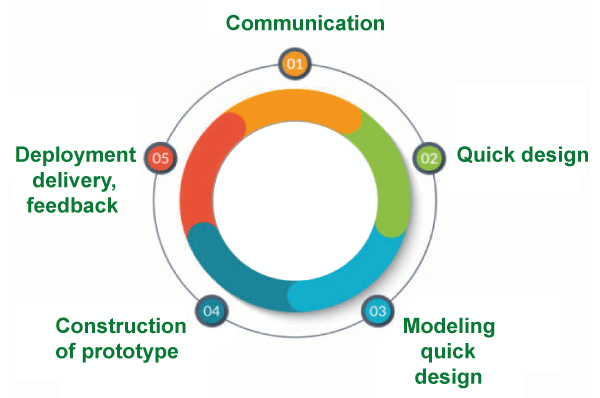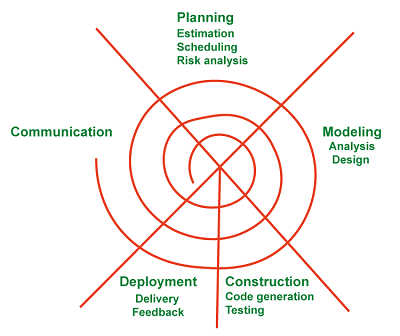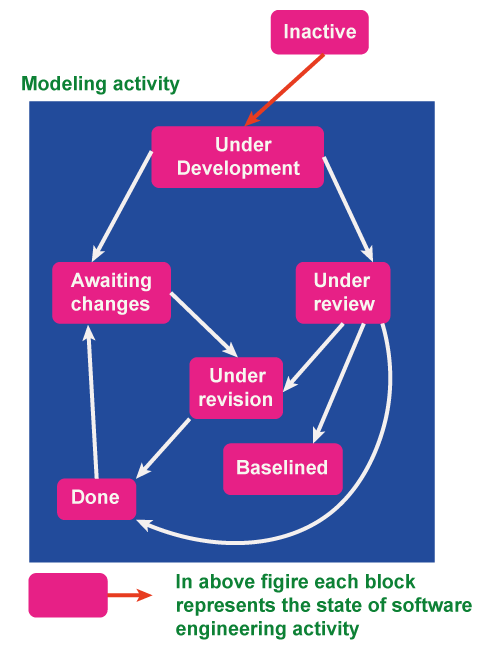Evolutionary Model in Software Engineering
This evolutionary model concept comes into the picture after the user faces the partially developed system rather than waiting for the fully developed version. The idea of this evolutionary model comes from developing the core module and then improving the software product by using iterative and incremental techniques with appropriate feedback.
In this evolutionary process model, the software product is in the sensitive version, which is made through many iterations, and then the final product is prepared. This evolutionary approach also suggests breaking down all the models into maintainable smaller chunks. After that, we can prioritize all the smaller products. After completing all the products, we can deliver those chunks one at a time to the users.
It plays a vital role in large projects where we can easily search the module for the implementation of incremental things. It is also an influential model because it collects customer feedback throughout the development process, and the customer can use the base feature of the project before the release of the entire working version.
What is the Evolutionary Model?
The evolutionary model is also known as successive versions or incremental models. The main aim of this evolutionary model is to deliver the products in total processes over time. It also combines the iterative and collective model of the software development life cycle (SDLC).
Based on the evolutionary model, we can divide the development model into many modules to help the developer build and transfer incrementally. On the other hand, we can also develop the skeleton of the initial product. Also, it refines the project to increase levels of capability by adding new functionalities in successive versions.
Characteristics of the Evolutionary Model
There are so many characteristics of using the evolutionary model in our project. These characteristics are as follows.
- We can develop the evolutionary model with the help of an iterative waterfall model of development.
- There are three types of evolutionary models. These are the Iterative model, Incremental model and Spiral model.
- Many primary needs and architectural planning must be done
- to implement the evolutionary model.
- When the new product version is released, it includes the new functionality and some changes in the existing product, which are also released with the latest version.
- This model also permits the developer to change the requirement, and the developer can divide the process into different manageable work modules.
- The development team also have to respond to customer feedback throughout the development process by frequently altering the product, strategy, or process.
Prototyping Model
We can define this prototyping model as the first form using all other forms created or copied. We can also call the prototyping model the set of general objects that helps to create the software. We can not identify the input and output of requirement details. We can develop the program quickly with the help of this model. We have some different phases of using this prototyping model. These are as follows.

- Communication
In this phase, the client and the developer should have a meeting, and in that meeting, they discuss the main objective of creating the project.
- Quick design
When we have the requirements known to the developer, then the developer can implement the quick design. The quick design includes implementing important aspects, such as the input and output format of the software. The main focus of this project is on the things visible to the user rather than the detailed plan. With the help of this, we can also create the prototype of the project.
- Modelling quick design
In this phase, we can get a clear idea about the software development because the software is now in the build state. Also, it allows the developer to understand the project's basic requirements.
- Construction of prototype
The customer evaluates the prototype of the project.
- Deployment, delivery, feedback
If the client is unsatisfied with the project, then the developer can recreate the project according to the client's satisfaction. This process repeats until the client is fully satisfied. After the client is happy, the project will be developed based on the final prototype.

Advantages of the Prototyping Model
There are so many benefits of using the prototype model. These are as follows:
- The prototype model does not need detailed input, output, processes, adaptability of the operating system, or entire machine interaction.
- The user is fully active in the development process of this model.
- The development process is the best platform for users to understand the project.
- We can easily detect the error with the help of this prototyping model.
- It also identifies the missing functionality very quickly.
- It also identifies the confusing or difficult functions.
Disadvantages of the Prototyping Model
Using a prototyping model also has some disadvantages. These are as follows.
- In this model, the involvement of the client is greater. So, it is not always considered by the developer.
- The development time is longer, so it is a prolonged process.
- The developer has to perform so many changes according to the client's demand. It disturbs the rhythm of the development process.
- When the user is confused with the prototype, then this prototype will be thrown away.
Spiral Model
This model is also known as the risk-driven process model. With the help of this spiral model, we can generate the software project. During the risk analysis, if a risk is found, an alternate solution should be suggested and implemented in the spiral model. We can also say that it combines the sequential or waterfall models and the prototype models. All the required activities are done in one iteration. The output of the large project is small.
The framework activities of the spiral model are as shown below.
Advantages of the Spiral Model
There are so many benefits of using the spiral model. These are as follows:
- The amount of risk should be reduced in this model.
- This model is best for large and critical projects.
- It provides the developer with solid approval and documentation control.
- The software production time is less in this spiral model.
Disadvantages of Spiral Model
It also has some disadvantages to using the spiral model. These are as follows.
- We need a lot of financial support to develop a project.
- We should not use this model for a very small project.
Concurrent Development Model
We also called this concurrent development model a concurrent model. In the first iteration process, all the communication activity has been completed. After completing the first iteration, it exits in the awaiting changes state. Also, in the initial phases, The modelling activity was completed. After completion of the initial phases, it goes to the underdevelopment state. If the customer wants some changes in the software product, then the modelling activity moves from the under-development state into the awaiting change state. This concurrent model changes from one activity to another activity.

Advantages of the Concurrent Development Model
There are so many benefits of using the concurrent development model. These are as follows:
- We can use this model in all types of software development processes.
- It is so much easier to understand.
- It also provides immediate feedback after the testing process is done.
- It also provides an accurate picture of the state of the project.
Disadvantages of the Concurrent Development Model
Using the concurrent development model also has some disadvantages. These are as follows.
- We have to improve communication between the team members.
- It requires remembering the status of the different activities.
Comparison of the Evolutionary Model with Other Models
1. Evolutionary Model vs Incremental Model
| Evolutionary |
Incremental |
| The requirement of this evolutionary model is not a requirement. The development can be changed according to the development process. |
The requirements for this incremental model are precise and based on the development team. |
| In this evolutionary model, the initial step is understanding the customer's requirements. Also, it involves the development of the core modules and functionality. After completing all the phases, they have to deliver the product to the customer for feedback. |
In this incremental model, each module is defined with multiple iterations. We can also add new functionality during the development of the product. After completing all the steps, we have to release the deliverable product. |
| The activities of the complete cycle are repeated for each new product version. |
Each module is developed, tested, and released at various intervals. |
| In this model, the development time is unknown for the developer. Also, the developer can not track the progress of the software product. |
In this model, the development time is known to the developer. Also, the developer can track the progress of the software product. |
2. Evolutionary Model vs Iterative Model
| Evolutionary Model |
Iterative Model |
| In this model, different modules are released in incremental order before releasing the final product. |
It follows the process of the sequential development process. After completion of the development of the software product, it releases the final product. |
| There will be a chance of delivery of actual product be late. |
In this model, the product will be delivered within the time. |
| In this module, the integration of the module will be complex. |
This model makes it much easier to understand and implement the product. |
| We can use this module only for large products. |
It is the most commonly used module in the software industry. |
3. Evolutionary Model vs Classical Waterfall Model
| Evolutionary Model |
Classical Waterfall Model |
| In this model, we can deal with the different versions of the software. |
In this model, we can deal with things according to the things mentioned in the testing manual. |
| In this model, integration is going to be complicated. |
In this model, it is going to be simple to use, understand and implement. |
| This model accepts customer feedback during the development of the project. |
In this model, there is no need for customer feedback. |
| In this model, we can detect the error in the core module of the project. |
In this phase, we can detect the error in every development step. |
| If we need to add any new functionality, we have to release the latest product, and the existing functionalities may be updated. |
After the completion of the development of the final product, we can not add any update to it. |
4. Evolutionary Model vs Spiral Model
| Evolutionary Model |
Spiral Model |
| In this model, we can develop the software incrementally with the help of different modules. |
In this model, all the modules are divided into many loops, further divided into four quadrants. |
| We can use this module only for large products. |
We can use this model to develop technically difficult software products vulnerable to different threats. |
| In this model, Every version can fully function the mentioned functionalities. |
In this module, each model contains a set of activities that the software performs. |
Advantages of the Evolutionary Model
There are so many benefits of using the evolutionary model. These benefits are as follows.
- In the evolutionary model, the user can test partially developed software before the release of the final product in the market.
- In this model, we can test the core module, which reduces the chances of errors in the final product.
- We can use this module only for large products.
- We can use this model to develop a software product with some unique features. We can modify these specific features based on customer feedback and many factors throughout development.
- With the help of this evolutionary model, we can get to know the client's requirements during the delivery of different versions of the software.
- After completion of each cycle, the user can access the product.
- Using an evolutionary model removes the requirement to allocate significant resources simultaneously for system development.
Disadvantages of the Evolutionary Model
There are also many disadvantages to using this model. These are as follows.
- It is difficult to divide the problem into functionality units that the user accepts. After receiving the user, this problem should be incrementally implemented, and after that, it should be delivered.
- There will be a chance of being late in the delivery of the final product. There will be a chance that the market can go down due to different customer changes during development.
- In this module, the chances of risk factors are high. There is always a need to report customers continuously.
|



 For Videos Join Our Youtube Channel: Join Now
For Videos Join Our Youtube Channel: Join Now









